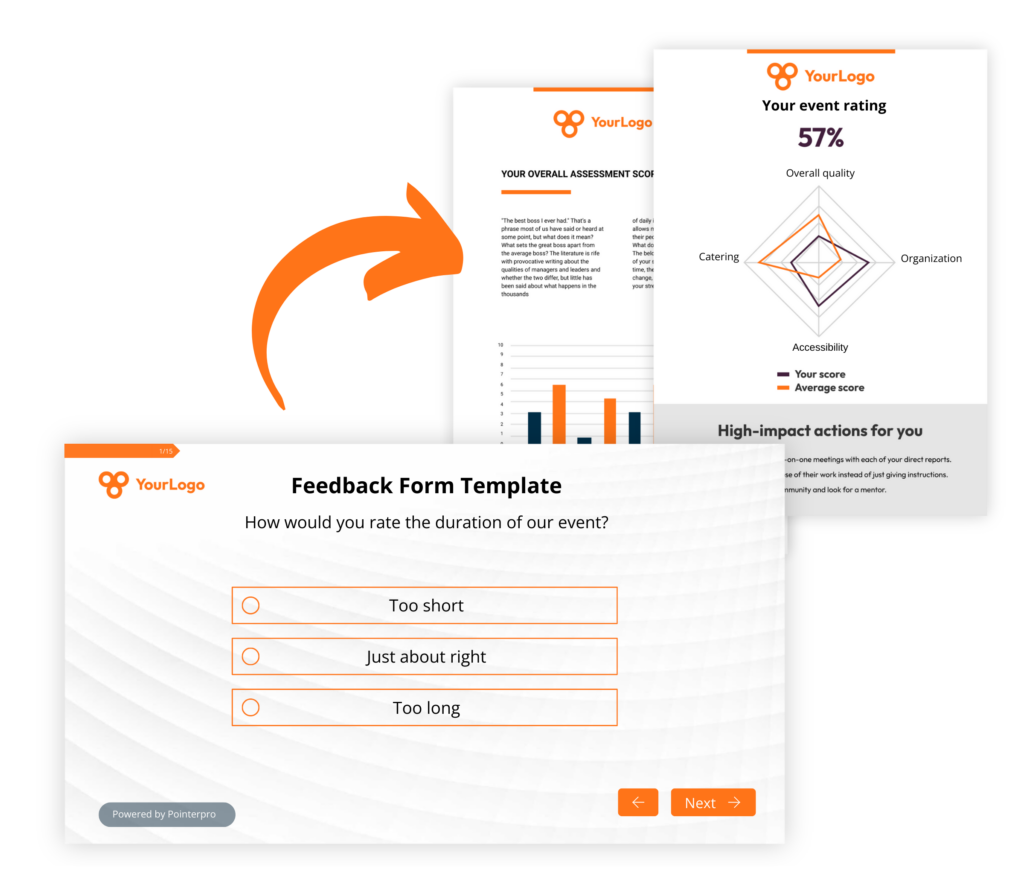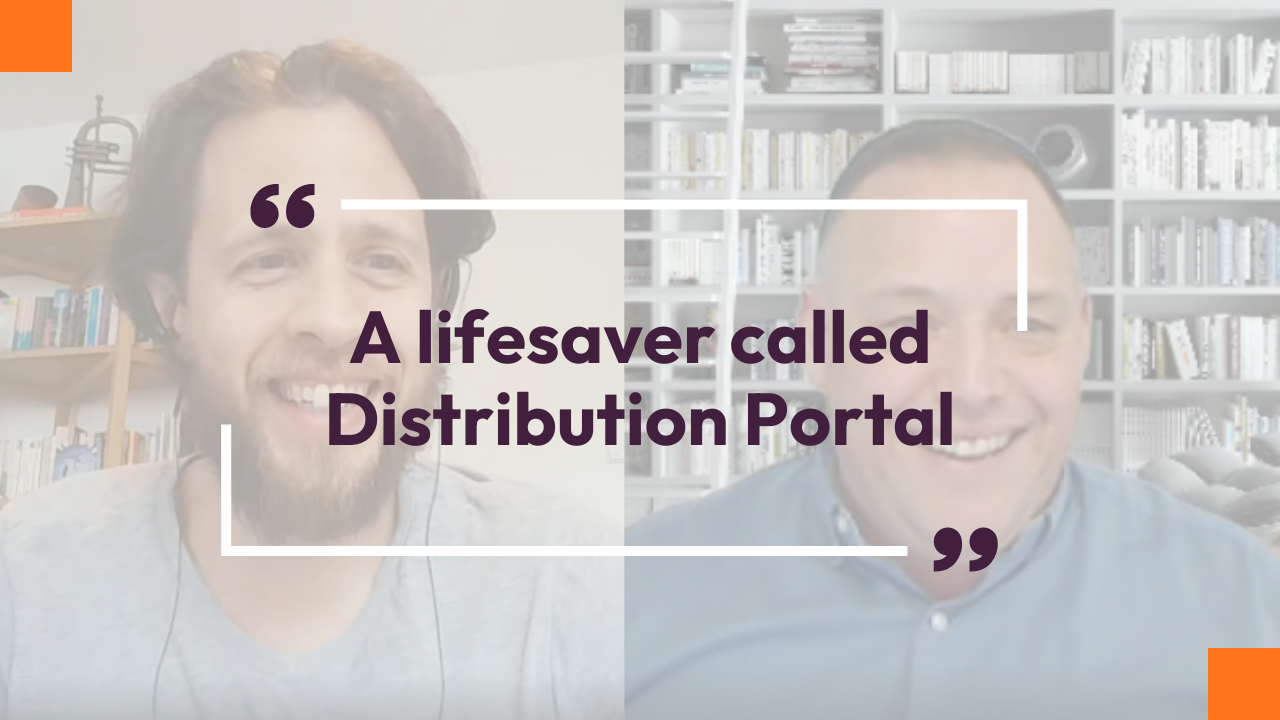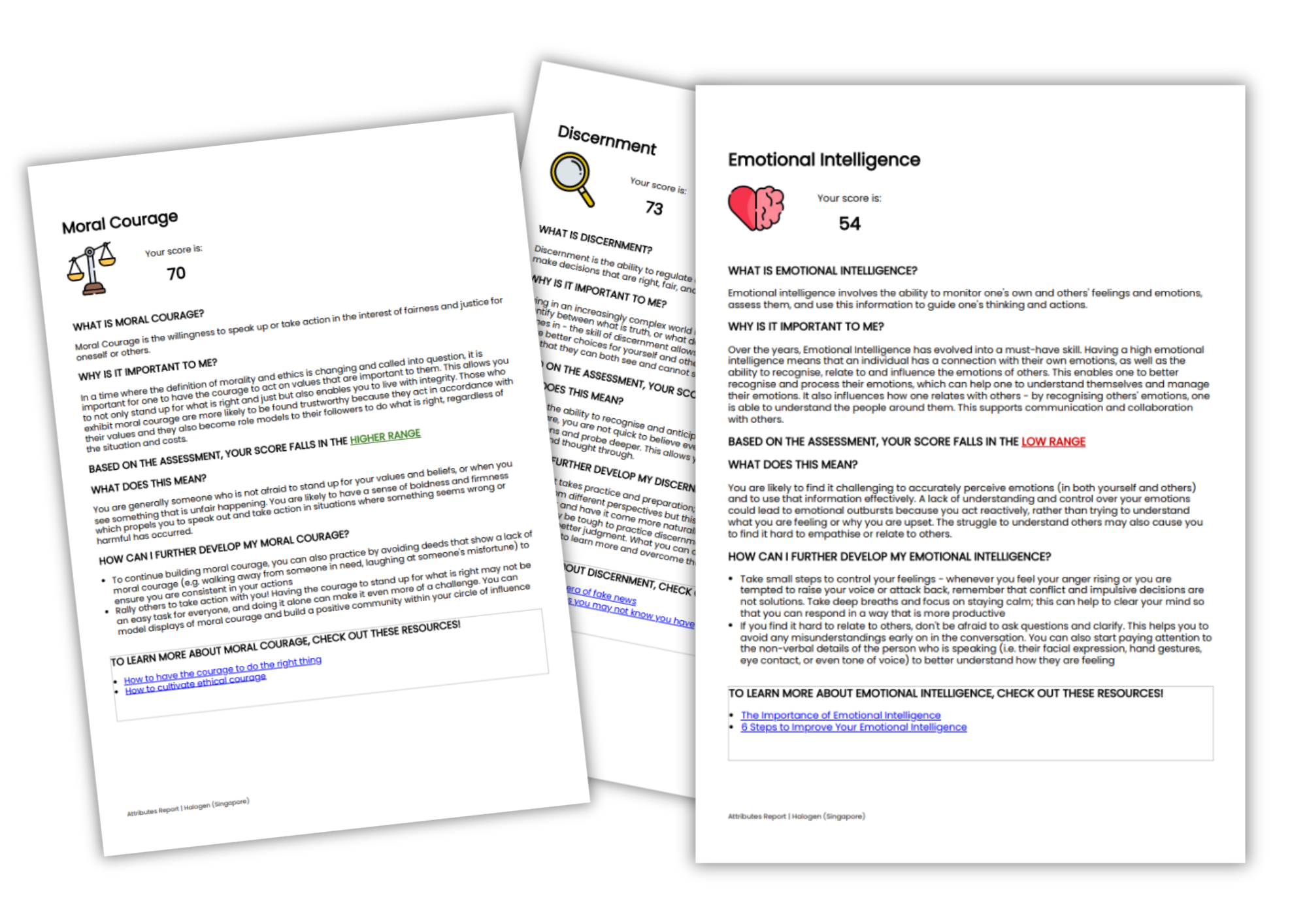Feedback form template
Boost response rates on your feedback form by incentivizing respondents with auto-personalized feedback.
With an effective feedback form, you gather objective information about people’s experience with your organization.
Pointerpro is the 2-in-1 software that combines assessment building with personalized PDF report generation.

How to create and use a feedback form?
A feedback form is a template or tool to gather opinions, suggestions, and reactions from people on a specific topic, service, product, event, or experience. Its primary purpose is to collect valuable information that can be used for improvement, decision-making, or assessment.
Important to note: Feedback is an ongoing process. Regularly collecting and acting on feedback helps in continuous improvement and staying aligned with your audience’s needs and expectations.
Creating and using a feedback form involves several steps, from designing the form to analyzing the feedback, but also even providing feedback yourself to the respondent. Here are 3 key tips for creating a feedback form that works:
- Types of questions: Use a mix of open-ended questions for qualitative feedback and closed-ended questions (like ratings, multiple choice) for quantitative analysis.
- Clarity and conciseness: Ensure questions are easy to understand and respond to. Also, limit the number of questions.
- Avoid leading questions: Questions should be neutral to get unbiased responses.
3 reasons to use Pointerpro as a feedback form tool
3 reasons to use Pointerpro as a feedback form tool
Interactive user experience
With the Questionnaire Builder, you get to create an engaging feedback form. How? With numerous design and layout options, useful widgets, and countless question types.
Refined, score-based analysis
Our custom scoring engine helps you quantify and categorize diverse answers. The result? An objective and nuanced assessment of your respondents’ feedback.
Automated feedback in PDF
Thanks to your setup in the Report Builder, respondents instantly get a detailed PDF report: with personalized responses, useful information, and your brand design.
1.500+ businesses worldwide build assessments with Pointerpro









7 feedback form template tips to boost your response rate
To boost the response rate for your feedback form, it’s essential to create a form that is engaging, easy to complete, and clearly valuable to both the respondent and the organization.
Here are 7 tips for designing a feedback form template that encourages more responses:
- Start with the most engaging questions: Begin with questions that are easy to answer and engaging. This can include simple yes/no questions or rating scales. A smooth start encourages respondents to continue through the rest of the form.
- Optimize for mobile users: Many people will access your form on a mobile device. Ensure your form is mobile-friendly, with responsive design elements that adjust to different screen sizes and easy-to-use navigation on a touchscreen.
- Offer anonymity: Assure respondents that their feedback can be anonymous. This often leads to more honest and valuable responses, as people feel more comfortable sharing their true opinions without fear of repercussions.
- Include a progress bar: Let respondents know how much of the form they've completed and how much is left. A progress bar helps manage expectations and reduces the likelihood of respondents abandoning the form partway through.
- Explain the purpose and follow-up: Clearly communicate the purpose of the feedback and how it will be used. This can motivate respondents to complete the form, especially if they understand the impact their feedback will have. Also, if possible, outline how and when you will follow up on the feedback received.
- Create an interactive experience: Engage respondents by making the response process interactive and enjoyable. This can be achieved by incorporating elements like visual aids, interactive question formats (such as sliders or clickable images), and gamification techniques.
- Provide extra response incentives: Come up with something to give back to the respondents. This could be a special offer, discount, or a chance to win a prize. But it can also be input from yourself on their feedback. A feedback form will often cover various respondents’ likes and dislikes. Based on these you might be able to make useful recommendations for them.
40 feedback form template example questions
Here are 40 feedback form example questions divided into 4 categories:
- 10 event feedback form example questions
- 10 customer feedback form example questions
- 10 product feedback form example questions
- 10 peer feedback form example questions
10 event feedback form example questions
- How would you rate the overall quality of the event?
- What was your favorite part of the event?
- Was the event length too long, too short, or about right?
- How satisfied were you with the venue and its facilities?
- How effective do you think the event was in achieving its stated goals?
- How would you rate the overall quality of the speakers/presenters?
- Was the event schedule and program well-organized and easy to follow?
- How likely are you to attend one of our events in the future?
- Do you have any suggestions for topics or activities for future events?
- Is there anything else about the event that you’d like to share?
These event feedback form template questions cover various aspects of an event, such as overall satisfaction, specific features like the venue and speakers, and the effectiveness in achieving event goals. They are designed to elicit both general and specific feedback, allowing for an assessment of what worked well and what could be improved.
The questions also encourage suggestions for future events. This fosters a sense of involvement and investment from the attendees. This set of questions can provide valuable insights for event organizers to enhance future event planning and execution.
10 customer feedback form example questions
- How would you describe your overall experience with our company?
- How easy was it to find the information or assistance you needed?
- How satisfied are you with the customer service you received?
- Were your interactions with our staff helpful and professional?
- How likely are you to continue doing business with us?
- What was your primary reason for choosing our company?
- How well do our values and mission align with your expectations?
- Could you share any memorable experiences you had with our company?
- How do you feel about the communication and updates you receive from us?
- What improvements would you suggest for our overall customer experience?
The customer feedback form template questions are designed to help understand the customer’s overall interaction with the company and their perception of the brand. This approach encompasses evaluating the quality of customer service, assessing how well the company’s values and mission resonate with the customer, and gauging overall satisfaction and loyalty.
It’s about capturing the customer’s complete journey with the company: From the ease of accessing information and services, to their impressions of company communications. The goal is to get a holistic view of the customer’s experience, identifying strengths and areas for improvement across all touchpoints with the brand.
10 product feedback form example questions
- How does our product meet your specific needs or requirements?
- How would you rate the quality and durability of the product?
- Was the product easy to use and understand right out of the box?
- How satisfied are you with the features and functionalities of the product?
- Have you experienced any issues or malfunctions with the product?
- How does our product compare with similar products you’ve used?
- What is your favorite feature of the product, and why?
- Is there any feature missing from the product that you would like to see?
- How likely are you to purchase other products from us based on this product?
- Would you appreciate more information or tutorials about using the product?
In contrast with the previous list, the product feedback template questions zoom in on the customer’s experience with a specific product. This method focuses on gathering detailed insights about the product’s features, quality, usability, and performance. It involves understanding how the product meets the customer’s needs, its ease of use right from the initial setup, and how it compares to competitors.
The feedback form template aims to uncover specific aspects of the product that customers love, dislike, or think are missing. This approach is critical for making targeted improvements to the product, enhancing user satisfaction, and guiding future product development.
10 peer feedback form example questions
In a peer feedback form, the approach centers on understanding and improving interpersonal dynamics, professional competencies, and teamwork within a group or organization. This type of feedback form is used to get insights into how individuals work together, their strengths and areas for improvement from the perspective of their colleagues.
- How effectively does the individual contribute to team projects and discussions?
- Can you provide an example of a time when this individual demonstrated strong problem-solving skills?
- How would you describe their ability to communicate and collaborate with the team?
- In what ways does this person exhibit leadership qualities, even if they are not in a leadership position?
- How receptive is the individual to constructive feedback and differing opinions?
- Can you identify any areas where the individual could improve their professional skills?
- How does this person handle stressful or challenging situations in the workplace?
- What strengths does the individual bring to the team that you find particularly valuable?
- How does the individual contribute to creating a positive and productive work environment?
- If you could suggest one area for professional development for this person, what would it be?
The focus of these feedback form template questions in particular is on collaborative skills, communication, problem-solving abilities, adaptability, and professional growth. Unlike customer or product feedback forms, peer feedback is inherently more personal and subjective. It aims to provide insights into how team members view each other’s contributions, strengths, and areas for improvement. This feedback is crucial for personal development, team dynamics, and fostering a culture of continuous improvement within an organization.
What Pointerpro clients are saying




Feedback form distribution: How to reach the largest possible audience
Reaching the largest possible audience with a feedback form (for commercial purposes) requires a multi-faceted approach that leverages various channels and strategies. Here are some effective strategies:
- Multi-channel distribution: Use multiple channels to distribute your feedback form. For example, if it's an online form, share it via email, social media platforms, your website, and through any community forums or groups relevant to your audience. For physical events, consider both digital and physical forms.
- Leverage email lists: If you have an email list of past attendees or customers, use it to send out your feedback form. Personalize the emails to increase engagement.
- Integrate with transactional communications: Include the feedback form in transactional emails such as purchase confirmations or post-event thank-you notes. This can be an effective way to catch people when their experience with your product or event is still fresh in their minds.
- Use reminders wisely: Send out reminders to fill in the feedback form, but do so sparingly to avoid annoying your audience. Timing the reminder just right is key – not too soon after the first request and not too late when the experience might no longer be fresh.
- Optimize for mobile users: Make sure your feedback form is mobile-friendly, as a significant portion of your audience will likely access it via a smartphone or tablet.
- Collaborate with influencers or partners: If appropriate, collaborate with influencers or partners who can share your feedback form with their audience, thereby expanding your reach.
When you build feedback forms with Pointerpro, you have the possibility to use the Distribution Portal. This feature allows you to delegate the distribution of your form or assessment to other stakeholders with a network.
For example: If you work for a big company or brand, you no longer have to send the form to the entire worldwide audience yourself. You don’t have to follow up on whether people have responded either. Instead, you divide that workload among co-workers (e.g. country managers). They take care of engaging to their network, you simply see the results come in on your Pointerpro platform.
How and why an engaging feedback form template can improve your services
Customer data gathered through feedback forms, is a goldmine of insights that can significantly improve service quality, customer satisfaction, and overall business performance. In the video below, Pointerpro Product Director Bruno tells you how.
Beyond the more obvious ones we’ve already covered, here are additional reasons why feedback forms are so valuable to improve your services:
- They help create personalized experiences: With detailed customer data, you can create more personalized experiences. This might involve customizing communications, recommendations, or services based on individual customer preferences and past interactions.
- They help predict future trends: Analyzing customer data helps in predicting future market trends and customer behaviors. This foresight can be crucial in staying ahead of the curve and adapting services to meet emerging needs.
- They enhance customer loyalty: By responding to customer feedback and making visible improvements, businesses make customers feel truly valued. As a result, they’ll feel more satisfied with your brand and become more loyal to your business.
- They help streamline service delivery: Customer data can highlight inefficiencies or bottlenecks in service delivery. Addressing these can lead to smoother, more efficient operations.
- They contribute to risk management: Understanding customer sentiment and feedback can also help in identifying potential risks or issues before they escalate, allowing for proactive management.
- They foster Innovative development: Customer feedback often serves as a source of ideas for innovation, leading to the development of new services or features that align with customer desires.
- They provide you with benchmarks: Customer data can serve as a benchmark to measure improvements and performance over time, ensuring that service enhancements are effective.
12 more common feedback form templates
Each of the following templates is designed to collect specific, targeted feedback in its respective area, aiding in enhancing services and customer experiences. What this list shows is that asking for feedback is practically always possible and useful.
- Lecturer feedback form template: Gathers students' opinions on teaching methods, clarity, and engagement levels of their lecturers, to improve teaching quality.
- Physical therapist feedback form template: Used by patients to evaluate their experience with physical therapists, focusing on treatment effectiveness, professional demeanor, and communication.
- Supplier feedback form template: Allows businesses to assess and provide feedback on their suppliers, covering product quality, delivery timeliness, and overall service.
- Food service feedback form template: Used by restaurants or food service providers to gather customer feedback on food quality, service, ambiance, and overall dining experience.
- IT support service feedback form template: Designed for users to rate their experience with IT support teams, focusing on response time, problem-solving effectiveness, and technical expertise.
- Hotel guest feedback form template: Guests provide feedback on their stay, evaluating room quality, amenities, staff service, and overall satisfaction.
- Retail customer feedback form template: Used by retail stores to gather customer opinions on product variety, store layout, staff helpfulness, and overall shopping experience.
- Gym member feedback form template: Allows gym members to share their thoughts on the facility, equipment quality, cleanliness, staff assistance, and fitness class offerings.
- Employee performance feedback form template: Enables colleagues and managers to provide feedback on an employee’s performance, skills, teamwork, and improvement areas.
- Healthcare patient feedback form template: Patients rate their experience with healthcare facilities, covering medical care quality, staff behavior, and facility cleanliness.
- Online course feedback form template: Collects feedback from learners about online courses, focusing on content quality, ease of access, instructor effectiveness, and course structure.
- Bank customer feedback form template: Allows bank customers to rate their satisfaction with services like account management, loan processing, customer service, and overall banking experience.
When you build feedback forms with Pointerpro, you have the possibility to use the Distribution Portal. This feature allows you to delegate the distribution of your form or assessment to other stakeholders with a network.
For example: If you work for a big company or brand, you no longer have to send the form to the entire worldwide audience yourself. You don’t have to follow up on whether people have responded either. Instead, you divide that workload among co-workers (e.g. country managers). They take care of engaging to their network, you simply see the results come in on your Pointerpro platform.
Conclusion: Feedback form templates are about more than data collection alone
Feedback form templates are a vital tool in building and maintaining meaningful relationships with customers, employees, or any target audience. At their core, all the templates discussed above are about understanding needs, perceptions, and experiences, enabling organizations to forge deeper connections with their stakeholders.
The use of feedback forms signifies an organization’s commitment to listening and responding to the concerns and suggestions of its audience. This practice fosters a sense of value and respect among those providing the feedback, as they see that their opinions are not only sought but also potentially acted upon. This two-way communication channel is crucial in establishing trust and loyalty, which are foundational to any long-term relationship.
Moreover, feedback forms can be instrumental in identifying trends and patterns that might not be evident through other data collection methods. These insights can lead to innovative strategies and solutions, driving continuous improvement and growth. By addressing specific feedback, organizations demonstrate adaptability and a customer-centric approach, which can significantly enhance their reputation and competitiveness.
Additionally, well-designed feedback forms can also serve as a tool for self-assessment and reflection for respondents, especially in educational or professional development settings. They encourage individuals to consider their experiences and articulate their thoughts, contributing to a more introspective and engaged feedback process.
In essence, feedback form templates are a cornerstone in the landscape of effective communication and organizational growth. They embody the principle that successful organizations are those that listen, understand, and evolve in response to the needs and insights of their communities.
Create your feedback form today
You may also be interested in
Recommended reading

Vlerick Business School digitalizes entrepreneurship development with Pointerpro [case study]
What do a top-tier international business school based in the capital of Europe and Pointerpro have in common? At the

Attain Global: How to do psychometric tests right and build a cutting-edge international business [case study]
In many countries worldwide, the pursuit of skillful and engaged employees is not so much a war on talent as

How youth development specialist Halogen reaches thousands of young Singaporeans with Pointerpro [case study]
Singapore, in Southeast Asia, is a global, economic powerhouse with a population of a little less than 6 million people.


